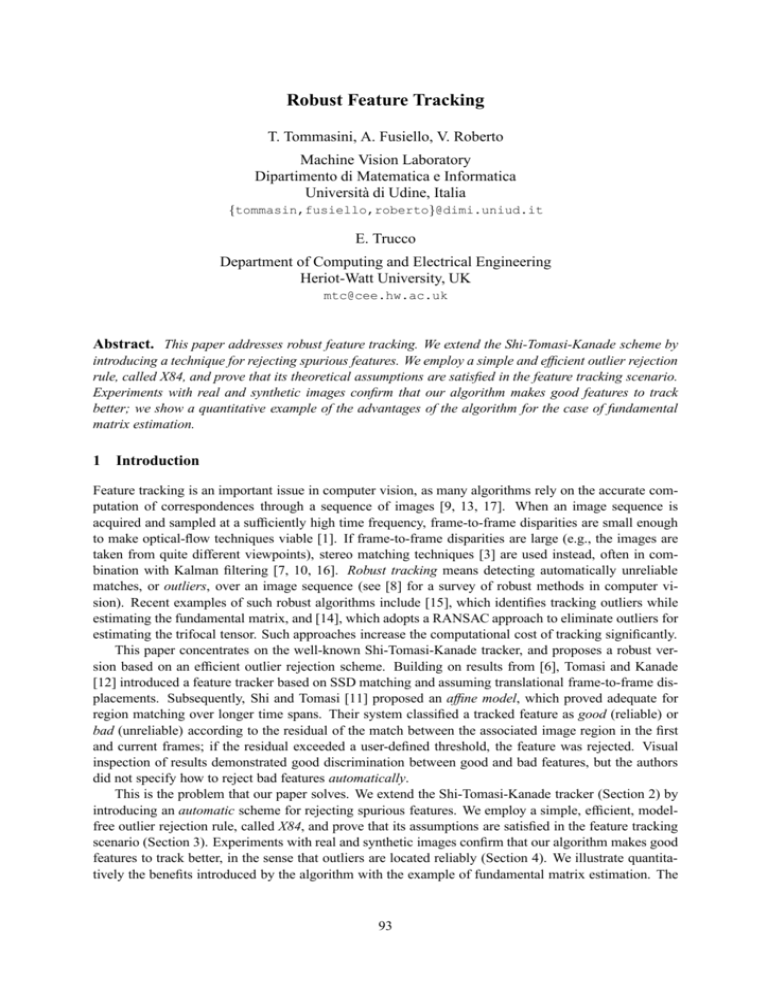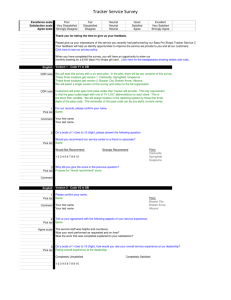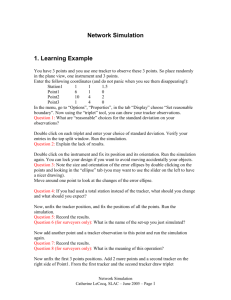Robust Feature Tracking
advertisement

Robust Feature Tracking T. Tommasini, A. Fusiello, V. Roberto Machine Vision Laboratory Dipartimento di Matematica e Informatica Università di Udine, Italia ftommasin,fusiello,robertog@dimi.uniud.it E. Trucco Department of Computing and Electrical Engineering Heriot-Watt University, UK mtc@cee.hw.ac.uk Abstract. This paper addresses robust feature tracking. We extend the Shi-Tomasi-Kanade scheme by introducing a technique for rejecting spurious features. We employ a simple and efficient outlier rejection rule, called X84, and prove that its theoretical assumptions are satisfied in the feature tracking scenario. Experiments with real and synthetic images confirm that our algorithm makes good features to track better; we show a quantitative example of the advantages of the algorithm for the case of fundamental matrix estimation. 1 Introduction Feature tracking is an important issue in computer vision, as many algorithms rely on the accurate computation of correspondences through a sequence of images [9, 13, 17]. When an image sequence is acquired and sampled at a sufficiently high time frequency, frame-to-frame disparities are small enough to make optical-flow techniques viable [1]. If frame-to-frame disparities are large (e.g., the images are taken from quite different viewpoints), stereo matching techniques [3] are used instead, often in combination with Kalman filtering [7, 10, 16]. Robust tracking means detecting automatically unreliable matches, or outliers, over an image sequence (see [8] for a survey of robust methods in computer vision). Recent examples of such robust algorithms include [15], which identifies tracking outliers while estimating the fundamental matrix, and [14], which adopts a RANSAC approach to eliminate outliers for estimating the trifocal tensor. Such approaches increase the computational cost of tracking significantly. This paper concentrates on the well-known Shi-Tomasi-Kanade tracker, and proposes a robust version based on an efficient outlier rejection scheme. Building on results from [6], Tomasi and Kanade [12] introduced a feature tracker based on SSD matching and assuming translational frame-to-frame displacements. Subsequently, Shi and Tomasi [11] proposed an affine model, which proved adequate for region matching over longer time spans. Their system classified a tracked feature as good (reliable) or bad (unreliable) according to the residual of the match between the associated image region in the first and current frames; if the residual exceeded a user-defined threshold, the feature was rejected. Visual inspection of results demonstrated good discrimination between good and bad features, but the authors did not specify how to reject bad features automatically. This is the problem that our paper solves. We extend the Shi-Tomasi-Kanade tracker (Section 2) by introducing an automatic scheme for rejecting spurious features. We employ a simple, efficient, modelfree outlier rejection rule, called X84, and prove that its assumptions are satisfied in the feature tracking scenario (Section 3). Experiments with real and synthetic images confirm that our algorithm makes good features to track better, in the sense that outliers are located reliably (Section 4). We illustrate quantitatively the benefits introduced by the algorithm with the example of fundamental matrix estimation. The 93 complete code of the robust tracker is available via ftp at: ftp://taras.dimi.uniud.it/pub/sources/rtrack.tar.gz. 2 The Shi-Tomasi-Kanade tracker In this section the Shi-Tomasi-Kanade tracker [11, 12] will be briefly described. Consider an image sequence I (x; t), with x = [x1 ; x2 ]> ; the coordinates of an image point. If the time sampling frequency is sufficiently high, we can assume that small image regions are displaced but their intensities remain unchanged: I (x; t) = I ((x); t + ); (1) where () is the motion field, specifying the warping that is applied to image points. The fast-sampling hypothesis allows us to approximate the motion with a translation, that is, (x) = x + d, where d is a displacement vector. The tracker’s task is to compute d for a number of selected points for each pair of successive frames in the sequence. As the image motion model is not perfect, and because of image noise, Eq. (1) is not satisfied exactly. ^ which minimises the SSD residual: The problem is then finding the displacement d X = [I (x + d; t + ) I (x; t)]2 (2) W where W is a small image window centered on the point for which d is computed. By plugging the first-order Taylor expansion of I (x + d; t + ) into (2), and imposing that the derivatives with respect to d are zero, we obtain the linear system Gd = e; where " # 2 G = W ggg1 gg1 g2 2 ; 1 2 2 P (3) e= P W h [g1 g2 ] >; ^ is the with gi =@I=@xi ; i=1; 2. The tracker is based on Eq. (3): given a pair of successive frames, d 1 ^ solution of (3), that is, d = G e, and is used to predict a new (registered) frame. The procedure is iterated according to a Newton-Raphson scheme, until convergence of the displacement estimates. 2.1 Feature extraction In this framework, a feature can be tracked reliably if a numerically stable solution to Eq. (3) can be found, which requires that G is well-conditioned and its entries are well above the noise level. In practice, since the larger eigenvalue is bounded by the maximum allowable pixel value, the requirement is that the smaller eigenvalue is sufficiently large. Calling 1 and 2 the eigenvalues of G, we accept the corresponding feature if min(1 ; 2 ) > ; where is a user-defined threshold [11]. 2.2 Affine Model The translational model cannot account for certain transformations of the feature window, for instance rotation, scaling, and shear. An affine motion field is a more accurate model [11], that is, (x) = Ax + d; (4) where d is the displacement, and A is a 2 2 matrix accounting for affine warping, and can be written as A = 1 + D, with D=[dij ] a deformation matrix and 1 the identity matrix. Similarly to the translational case, one estimates the motion parameters, D and d, by minimising the residual X = [I (Ax + d; t + ) I (x; t)]2 : (5) W 94 By plugging the first-order Taylor expansion of I (Ax+d; t+ ) into (5), and imposing that the derivatives with respect to D and d are zero, we obtain the linear system T z = a; in which z = [d11 with U 2 6 = 64 2 2 d12 d21 d22 d1 d2 ]> contains the unknown motion parameters, and " # X X U V > h [x1g1 x1g2 x2 g1 x2g2 g1 g2 ] ; T = a= ; > W V G W 2 2 x1 g1 x1 g1 g2 x1 x2 g1 x1 x2 g1 g2 x1 g1 g2 x1 g2 x1 x2 g1 g2 x1 x2 g2 x 1 x 2 g1 x1 x2 g1 g2 x 2 g1 x2 g1 g2 x1 x2 g1 g2 x1 x2 g2 x2 g1 g2 x2 g2 2 2 (6) 2 2 2 2 2 2 2 2 2 2 3 7 7; 5 V >= 2 2 x1 g1 x1 g1 g2 x2 g1 x2 g1 g2 x1 g1 g2 x 1 g2 x2 g1 g2 x2 g2 2 2 : Again, Eq. (6) is solved for z using a Newton-Raphson iterative scheme. If frame-to-frame affine deformations are negligible, the pure translation model is preferable (the matrix A is assumed to be the identity). 3 Robust Monitoring To monitor the quality of the features, the tracker checks the residuals between the first and the current frame: high residuals indicate bad features which must be rejected. Following [11], we adopt the affine model, as a pure translational model would not work well with long sequences: too many good features are likely to undergo significant rotation, scaling or shearing, and would be incorrectly discarded. Nonaffine warping, which will yield high residuals, is caused by occlusions, perspective distorsions and strong intensity changes (e.g. specular reflections). This section introduces our method for selecting a robust rejection threshold automatically. 3.1 Distribution of the residuals We begin by establishing which distribution is to be expected for the residuals when comparing good features, i.e, almost identical regions. We assume that the intensity I ( (x); t) of each pixel in the currentframe region is equal to the intensity of the corresponding pixel in the first frame I (x; 0) plus some Gaussian noise n' (0; 1). Hence I ((x); t) I (x; 0) ' (0; 1): Since the square of a Gaussian random variable has a chi-square distribution, we obtain [I ((x); t) I (x; 0)]2 ' 2 (1): The sum of n chi-square random variables with one degree of freedom is distributed as a chi-square with n degrees of freedom (as it is easy to see by considering the moment-generating functions). Therefore, the residual computed according to (2) over a N N window W is distributed as a chi-square with N 2 degrees of freedom: X = [I ((x); t) I (x; 0)]2 ' 2(N 2 ): (7) W As the number of degrees of freedom increases, the chi-square distribution approximates a Gaussian, which is in fact used to approximate the chi-square whenever N > 30. Therefore, since the window W associated to each feature is at least 7 7, we can safely assume a Gaussian distribution of the residual for the good features: ' (N 2 ; 2N 2 ): 95 3.2 The X84 rejection rule When the two regions over which we compute the residual are bad features (they are not warped by an affine transformation), the residual is not a sample from the normal distribution of good features: it is an outlier. Hence, the detection of bad features reduces to a problem of outlier detection, which is equivalent to the problem of estimating the mean and variance of the corrupted Gaussian distribution. To do this, we employ a simple but effective model-free rejection rule, X84 [5], which achieves robustness by employing median and median deviation instead of the usual mean and standard deviation. This rule prescribes to reject values which are more than k Median Absolute Deviations (MADs) away from the median: MAD = med fji med j jg: i j (8) In our case, i are the tracking residuals. A value of k = 5:2, under the hypothesis of Gaussian distribution, is adequate in practice, as it corresponds to about 3.5 standard deviations, and the range [ 3:5; + 3:5] contains more than the 99.9% of a Gaussian distribution [5]. The rejection rule X84 has a breakdown point of 50%: any majority of the data can overrule any minority. 3.3 Photometric normalisation Our robust implementation of the Shi-Tomasi-Kanade tracker incorporates also a normalised SSD matcher for residual computation. This limits the effects of intensity changes between frames, by subtracting the average grey level (J ; I ) and dividing by the standard deviation (J ; I ) in each of the two regions considered: " #2 X J (Ax + d) J I ( x) I = (9) : W J I where J ()=I (; t + 1) , I ()=I (; t). A more elaborate normalisation is described in [2]; [4] reports a modification of the Shi-TomasiKanade tracker based on explicit photometric models. 4 Experimental results Fig. 1: First (left) and last frame of the Artichoke sequence. 96 We evaluated our tracker in a series of experiments, of which we report only some, for reason of space. Figure 1 shows the result of the tracking algorithm on the Artichoke sequence, the same used by [13]. It is a 99-frame sequence (480 512 pixels), taken by a camera translating in front of the static scene. In the last frame, filled windows indicate features rejected by the robust tracker. We plotted the residuals of all features against the frame number (Fig. 2). The residuals of all the 10 features involved in occlusions become very high and are identified and rejected correctly by X84. −3 4 x 10 3.5 3 residual 2.5 2 1.5 1 0.5 0 10 20 30 40 50 60 70 80 90 # frame Fig. 2: Residuals magnitude against frame number for Artichoke. The arrows indicate the threshold (0.00004) set automatically by X84. To illustrate quantitatively the benefits of our robust tracker, we used the feature tracked by robust and non-robust versions of the tracker to compute the fundamental matrix between the first and last frame of four sequences (not shown here), then computed the RMS distance of the tracked points from the corresponding epipolar lines, using Zhang’s code [17] (if the epipolar geometry is estimated exactly, all points should lie on epipolar lines). The results are shown in Table 1. In all cases, the robust tracker brings a decrease in the RMS distance. All X84 Artichoke 1.40 0.19 Hotel 0.59 0.59 House 0.97 0.96 Stairs 0.66 0.15 Platform 1.49 1.49 Table 1: RMS distance of points from epipolar lines. The first row gives the distance using all the features tracked, the second using only the features kept by X84. 5 Conclusions We have presented a robust extension of the Shi-Tomasi-Kanade tracker, based on the X84 outlier rejection rule. The computational cost is much less than that of schemes based on robust regression and random sampling like RANSAC or LMedSq [8, 14], yet experiments indicate excellent reliability in the presence of non-affine feature warping (most reliable features preserved, all unreliable features rejected). Our experiments have also pointed out the pronounced sensitivity of the Shi-Tomasi-Kanade 97 tracker to illumination changes. We believe that our robust tracker can be useful to the large community of researchers needing efficient and reliable trackers. To facilitate dissemination and enable direct comparisons and experimentation, we have made the code available on the Internet. References [1] J. L. Barron, D. J. Fleet, and S. Beauchemin. Performance of optical flow techniques. International Journal of Computer Vision, 12(1):43–77, 1994. [2] I.J. Cox, S. Roy, and S.L. Hingorani. Dynamic histogram warping of image pairs for constant image brightness. In Proceedings of the IEEE International Conference on Image Processing, pages 366–369, 1995. [3] A. Fusiello, V. Roberto, and E. Trucco. Efficient stereo with multiple windowing. In Proceedings of the IEEE Conference on Computer Vision and Pattern Recognition, pages 858–863, Puerto Rico, June 1997. IEEE Computer Society Press. [4] G.D. Hager and P.N. Belhumeur. Real-time tracking of image regions with changes in geometry and illumination. In Proceedings of the IEEE Conference on Computer Vision and Pattern Recognition, pages 403–410, 1996. [5] F.R. Hampel, P.J. Rousseeuw, E.M. Ronchetti, and W.A. Stahel. Robust Statistics: the Approach Based on Influence Functions. Wiley Series in probability and mathematical statistics. John Wiley & Sons, 1986. [6] B. D. Lucas and T. Kanade. An iterative image registration technique with an application to stereo vision. In Proceedings of International Joint Conference on Artificial Intelligence, 1981. [7] L. Matthies, T. Kanade, and R. Szelisky. Kalman filter based algorithms for estimating depth from image sequences. International Journal of Computer Vision, 3:209–236, 1989. [8] P. Meer, D. Mintz, D. Y. Kim, and A. Rosenfeld. Robust regression methods in computer vision: a review. International Journal of Computer Vision, 6:59–70, 1991. [9] L. Robert, C. Zeller, O. Faugeras, and M. Hébert. Applications of non-metric vision to some visually-guided robotics tasks. In Y. Aloimonos, editor, Visual Navigation: From Biological Systems to Unmanned Ground Vehicles, chapter 5, pages 89–134. Lawrence Erlbaum Associates, 1997. [10] L.S. Shapiro, H. Wang, and J.M. Brady. A matching and tracking strategy for indipendently moving objects. In Proceedings of the British Machine Vision Conference, pages 306–315. BMVA Press, 1992. [11] J. Shi and C. Tomasi. Good features to track. In Proceedings of the IEEE Conference on Computer Vision and Pattern Recognition, pages 593–600, June 1994. [12] C. Tomasi and T. Kanade. Detection and tracking of point features. Technical Report CMU-CS-91-132, Carnegie Mellon University, Pittsburg, PA, April 1991. [13] C. Tomasi and T. Kanade. Shape and motion from image streams under orthography – a factorization method. International Journal of Computer Vision, 9(2):137–154, November 1992. [14] P. H. S. Torr and A. Zisserman. Robust parameterization and computation of the trifocal tensor. In R. Fisher and E. Trucco, editors, British Machine Vision Conference, pages 655–664. BMVA, September 1996. Edinburgh. [15] P. H. S. Torr, A. Zisserman, and S. Maybank. Robust detection of degeneracy. In E. Grimson, editor, Proceedings of the IEEE International Conference on Computer Vision, pages 1037–1044. Springer–Verlag, 1995. [16] E. Trucco, V. Roberto, S. Tinonin, and M. Corbatto. SSD disparity estimation for dynamic stereo. In R. B. Fisher and E. Trucco, editors, Proceedings of the British Machine Vision Conference, pages 342–352. BMVA Press, 1996. [17] Z. Zhang. Determining the epipolar geometry and its uncertainty: A review. Technical Report 2927, INRIA Sophia-Antipolis, France, July 1996. 98





